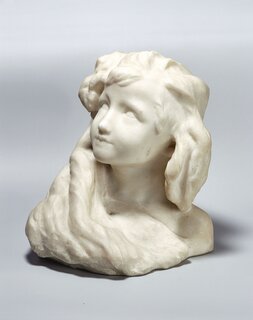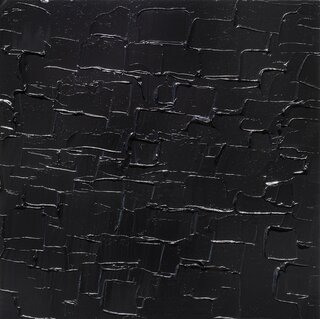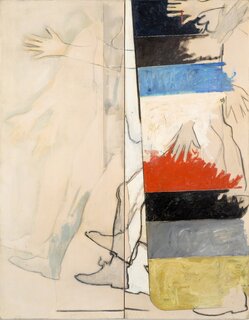
"The ravaged forms [of my works] were all conceived as full and complete. Only afterwards did I crush them, tear them, so that they would be different from each side and so that they would have a changeable and living quality.
—Germaine Richier
In Germaine Richier’s Le Grain (1955), the natural and the extraordinary meet in the sculpted form of an emaciated female figure. Originally modeled in clay, the standing woman displays at once the earthen presence of that material and the forces of erosion, analogous to the transformation imposed on the work by the sculptor’s hands. Le Grain features a compelling interplay between the sculptural thickness of the human figure and the negative space that divides and intersects it: appearing as if the bones and musculature of the body had been rent apart, transforming the woman into a creature more and less than human. She stands, transfigured by starvation, arrested in a moment of meditative stillness while winnowing grain from an ear of corn. In Richier’s oeuvre, the present sculpture is singular in its dual representation of whole and degraded form. Valérie Da Costa has written, “Germaine Richier reveals the chaotic inner life of form, the original magma from which the figure emerges.” Evocative of the solidified human figures at Pompeii, which Richier had seen in 1935 and which left a lifelong impact on her, the suffering body of Le Grain exemplifies Richier’s captivating portrayal of life laid bare.
Executed at a mature stage in Richier’s career, Le Grain represents the apex of her radically experimental postwar period, distinguished by an exploration and manipulation of the sculptural representations of the human body. Richier’s work prior to World War II was, by contrast, more classical and contained; in the wake of the war and its horrors, she, like many other artists of her generation, felt the necessity to respond to and critique such unprecedented violence by introducing it into her artistic practice in newly creative ways. In 1955, Richier conceived the present work on the occasion of her retrospective exhibition at the Musée d’Art Moderne in 1956, which marked the height of her public recognition during her career. In addition to a smaller version, L’Epi (1955), Le Grain constitutes the culmination of the approach that Richier cultivated in the early 1950s, creating elongated figures with dramatic distortions and gaps, captured in the midst of their interactions with various objects. This theme is similarly portrayed in the sculptures Don Quichotte (1951) and La Jeune Fille et l'Oiseau (1954).
Additional casts of Le Grain are held by the Musée Picasso at Antibes, France; Smart Museum of Art at the University of Chicago; and Hirshhorn Museum and Sculpture Garden, Washington, DC. Casts of related works such as Le Diablo (1950), L’Ouragane (1948–49), L’Orage (1947–48), and L’Eau (1953–54) are held in the permanent collections of the Centre Pompidou, Paris, and the Tate, London. The Tate’s collection also comprises a cast of the associated sculpture Le Berger des Landes (1951). "




